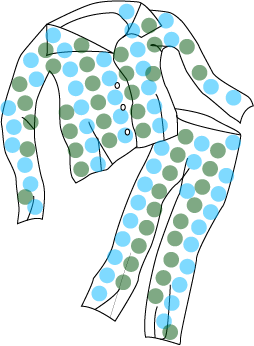 For many students, attending college comes with a variety of new freedoms, among those is the absence of rigid school dress codes. While some may view dressing for comfort as an indication of laziness or as a lack of professionalism, dressing casually for classes signifies shifting priorities and values: maybe even ones that counter biases that equate appearance with competence or character.
For many students, attending college comes with a variety of new freedoms, among those is the absence of rigid school dress codes. While some may view dressing for comfort as an indication of laziness or as a lack of professionalism, dressing casually for classes signifies shifting priorities and values: maybe even ones that counter biases that equate appearance with competence or character.
For comfort-dressers, the proliferation of the ‘loungewear’ industry was a silver-lining of the COVID-19 pandemic. When nationwide lockdowns constrained people to their homes, fashion companies acclimated to consumer needs. Just as remote and hybrid work have persisted post-pandemic, so have loungewear wardrobe trends.
However, shifts in work culture are not the only reason that dressing for comfort has gained popularity. Eighty percent of surveyed adults said they would be more cognizant about practicing self-care after the pandemic, according to a June 2020 report by The Harris Poll. The U.S. wellness economy is also projected to continue growing in the coming years.
Post-pandemic consumer activities and attitudes have reoriented cultural values around practices that favor comfort and self-care. The simultaneity of the 2010s body positivity movement reinforced these values by encouraging people to practice self-acceptance and divest energy from conforming to harmful beauty standards.
Dressing comfortably for class also serves more practical purposes. As students juggle a laundry list of obligations — including assignments, attending class and extracurriculars — it may be beneficial to skip the stress of picking out an outfit as an act of time management.
I do so myself as an act of passive resistance: I’m aware that my perceived attractiveness is a form of capital with tangible consequences. But I strive to self-cultivate a comfortable learning environment in order to prioritize academic success — which I know will help me accomplish more meaningful goals — rather than play into reductive cultural messaging that ultimately doesn’t serve me or women as a whole.
I don’t claim to be holier-than-thou, either. I care about my appearance just as much as the next person and when I reach for a pair of sweatpants and a sweatshirt each day before class, I’m certainly not thinking about how I am resisting a capitalist patriarchy by doing so.
Still, there are advantages to reframing how we think about our appearances, even in subtle ways like apparel choice, according to Renee Engeln, a professor of psychology at Northwestern University.
“If you can’t sit comfortably in an outfit, that’s a guarantee that it will steal valuable brain space from you when you wear it,” Engeln writes in her book, “Beauty Sick: How the Cultural Obsession with Appearance Hurts Girls and Women.”
Engeln’s own research backs up her claims. In a 2021 study, she found that women are significantly more likely than men to wear clothing that necessitates adjustment or monitoring throughout the day, makes it difficult to take deep breaths and leaves welts on their bodies, ultimately disrupting their quality of life and deterring their focus.
When dressing for class, students — regardless of gender — should consider prioritizing comfort. That’s not to mitigate the very real consequences of appearances; a comfort-driven wardrobe approach probably won’t fare well in a job interview, but professors are likely not concerned with the fashions choices their students make, and students should continuously examine what practices best support their goals and values.



Leave a Comment